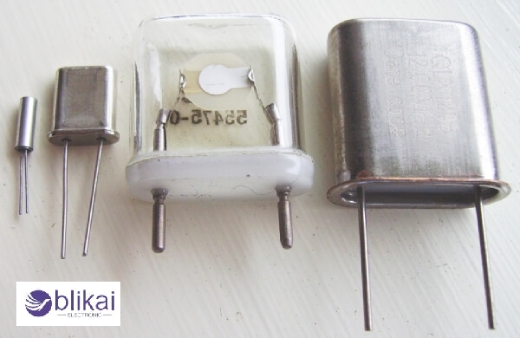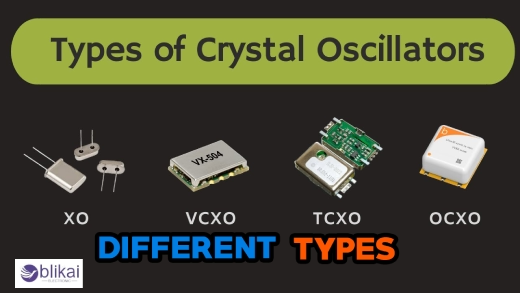How Does a Crystal Oscillator Work
Understanding Crystal Oscillators
A crystal oscillator is an electrical circuit for generating an electrical frequency with exceptional precision based on the mechanical resonance of a vibrating crystal. A crystal oscillator operates on the principle of piezoelectricity and is made up of a few unique materials, most often quartz. This is balanced by using the frequency of oscillations of the crystal itself. The oscillation serves as the master timing reference the wristwatch counts on to determine the time signal within that gadget or, in the case of telecommunications, very complex units such as 3G and 4G equipment.

Key Components of a Crystal Oscillator
- Crystal: Usually made from quartz, the main component of the oscillator.
- Oscillator circuit: Typically consists of an amplifier and feedback network.
- Capacitors: Used for frequency adjustment and stability.
- Resistors: Help in biasing and controlling the oscillator's operation.
- Power supply: Provides the necessary energy for sustained oscillation.
Types of Crystal Oscillators
- Pierce oscillator: A common type used in microcontrollers and digital circuits.
- Colpitts oscillator: Known for its stability and use in radio frequency applications.
- Temperature-compensated crystal oscillator (TCXO): One means is to provide stable temperature variation.
- Oven-controlled crystal oscillator (OCXO): In this manner, it has high-temperature stability since it cannot be influenced much by the external environment.

The Science Behind Crystal Oscillators
Piezoelectric effect explained
In basic terms, it is one such phenomenon whereby specific crystalline materials, chiefly quartz crystals, produce an electric charge when subjected to mechanical stress and vice versa. Therefore, piezoelectricity is responsible for the operation of a crystal oscillator. Application of a sufficient electric field across the quartz crystal produces a slight deformation and returns to its original shape upon removal of the field, thereby producing a tiny electric current. A bidirectional conversion of energy characteristics would explain why crystal oscillators are so precise and reliable.
The resonant frequency and its importance
Every crystal possesses an inherent resonant frequency at which it vibrates most effectively. This frequency is determined chiefly by the crystal's physical parameters, such as dimensions, geometry, and cut. When an alternating electric field is applied across the crystal at the resonant frequency, the crystal oscillates at that resonant frequency in a stable, self-sustaining manner. The significance of that resonant frequency is that it provides a steady and very accurate reference point for timekeeping and frequency generation in electronics.
How crystal cut affects performance
How a crystal is cut from raw quartz material significantly impacts its performance characteristics. Different cuts, such as AT-cut, BT-cut, or SC-cut, result in varying frequency stability, temperature sensitivity, and aging rates. For instance, the popular AT-cut crystals offer excellent frequency stability over a wide temperature range, making them ideal for many applications. The crystal cut also influences the crystal's Q factor, which measures its efficiency in storing energy and determines the oscillator's frequency precision and phase noise performance.
Operating Principles of Crystal Oscillators
Startup process
The startup process begins when power is applied to a crystal oscillator circuit. Initially, the circuit had some electrical noise, which provided small excitation to the crystal, forcing it to vibrate. This weak output from the crystal is fed back into the amplifier circuit.
The amplifier then reinforces this signal, increasing its amplitude. This amplified signal is fed back to the crystal, enhancing its vibration. This positive feedback loop continues until the oscillation reaches a stable amplitude, typically within milliseconds.
Steady-state operation
As the four-second wavelength is reinforced in the amplifier, its amplitude is raised. This amplified signal- the feedback signal- is fed back onto the crystal, enhancing its vibrations. The positive feedback loop continues until the oscillation stands at a stable amplitude, usually within a few milliseconds.
The crystal's high Q factor (quality factor) maintains frequency stability. It acts as a narrow bandpass filter, rejecting frequencies that deviate from its resonant frequency, thus ensuring a pure, single-frequency output.
Temperature effects on oscillation
Temperature variations can significantly affect the operation of different crystal oscillators. As the temperature changes, a crystal's size and elastic properties change. These changes alter the crystal's resonant frequency, leading to frequency drift.
Compensating schemes attempt to counter the effects of temperature change. The TCXO, or temperature-compensated crystal oscillator, works by further circuiting at the crystal oscillator frequency to provide a relative frequency that is affected directly by known temperature values. The OCXO, or oven-controlled crystal oscillator, is equipped to provide temperature control to the crystal, thus guaranteeing better frequency stability from thermal variations.
Applications of Crystal Oscillators
A. Timekeeping devices
Crystal oscillators are indispensable to timekeepers, providing the heartbeat for millions of clocks and watches. Their frequency stability makes their use crucial for both analog and digital time devices. In everything from simple wristwatches to large wall clocks, crystal oscillators assure accurate time through a steady pulse that drives the actual timekeeping mechanism.
B. Telecommunications
Crystal oscillators are the background players that ensure clear communication in telecommunications. They provide a stable reference frequency for radio transmitters and receivers so that signals are correctly transmitted and received. This precision is necessary for clear voice calls, data transmissions, and satellite communications.
C. Digital electronics
A crystal oscillator is an essential element of electronic circuits. They generate clock cycles that microprocessors, microcontrollers, and other devices utilize. Such signals are necessary for synchronizing many operations in complex electronic systems. From computers to smartphones, these oscillators ensure that all components work harmoniously, enabling the precise execution of instructions and data processing.
D. Aerospace and military use
Aerospace and military applications rely on crystal oscillators for high-accuracy timing and frequency control mechanisms. Crystal oscillators provide precise timing in navigation systems such as GPS, which is paramount when determining location. They also find applications in radar systems, secure communications equipment, and flight control systems, where reliability and accuracy are critical.
Advantages and Disadvantages
High-frequency stability
Crystal oscillators can be very stable in frequency, which gives them an advantage whenever timing and synchronization must be very effective. The natural properties of the crystal allow a very consistent resonation frequency when allowed to oscillate over extended periods to within a few parts per million in some cases. This is of the utmost importance in telecommunications, where precise timing is necessary to allow devices and networks to synchronize.
Low power consumption
Another huge plus of the crystal oscillator is that it is energy-efficient. They are ideal candidates for portable electronic devices and battery-run applications. Others have espoused the crystal oscillator as an efficient means of power consumption; its application in electronic systems allows more extended battery life and lower consumption levels by others. This aspect finds a place in modern-day IoT and wearable technologies where saving energy is important.
Temperature sensitivity
While crystal oscillators offer many benefits, they are not without disadvantages. One such drawback is their sensitivity to temperature fluctuations. Any change in temperature will affect the crystal's resonant frequency, which, in turn, introduces timing errors. TCXOs and OCXOs were developed to overcome this problem. These specialized oscillators incorporate additional circuitry or temperature control mechanisms to maintain stability across various temperatures.
Aging effects
While crystal oscillators also have aging effects, the frequency may change slowly. This aging is due to mechanical stress, contamination, or changes in crystal structure. Although the aging process is typically small, changes can be significant when long-term stability is critical in applications. High-precision applications may require periodic calibration or reference measurements against atomic clocks to compensate for this limitation.
Selecting the Right Crystal Oscillator
Frequency range considerations
Frequency ranges are key when selecting a crystal oscillator. For some, it could range from a few kilohertz to a hundred megahertz broadcast frequency range. Real-time clocks may call for low-frequency oscillators (for example, 32.768 kHz), while high-speed digital systems require even higher frequencies (10-100 MHz). Selecting one capable of supplying an accurate frequency needed for your duty is essential.
Environmental factors
Environmental considerations are also critical in determining the performance and practical operational lifetime of crystal oscillators. Oscillator stability and accuracy depend largely upon temperature, humidity, and vibrations. For applications in harsh environments, consider oscillators with wide temperature ranges or those constructed for rugged conditions. Some oscillators come with temperature compensation features to maintain stability across varying temperatures.
Cost-effectiveness
While high-precision oscillators offer excellent performance, they often have a higher price tag. It's essential to balance the required performance with budget constraints. More moderately priced models still suffice when performance is not critical. In cases where timing is paramount, investing in a higher-grade oscillator may help avoid economic disasters and system failures.
Size and packaging options
The continued downsizing of electronic devices raises the increasing importance of the size and packaging of crystal oscillators. The newer oscillators come in various form factors ranging from through-hole to surface-mount package designs. Consider the available space on your PCB and the mounting method that best suits your manufacturing process. Smaller packages like SMD (Surface Mount Device) are ideal for compact designs, while larger packages might offer better stability or easier handling during assembly.
Related Articles
Different Types of Crystal Oscillators: Explain
Crystal Oscillators: Types, Features and Applications
What is Hartley Oscillator: Circuit, Working, and its Applications
556 Timer Circuits: Features, Specification and Applications
What is an Integrated Circuit?
What is an Integrated Circuit? Applications, Functions and Types (Guide)
Integrated circuit chip: Types, Applications, and FAQ
Microprocessor Vs Integrated Circuit: What’s the Differences?
Varistors: How Do They Safeguard Circuits?
Phototransistor : Circuit Pinout & Principle
Simple Electronic Circuits for Beginners
Watt Amplifier Circuit:Types,Principle and Applications
LM386 Audio Amplifier Circuit: Features, Applications and Datasheet










